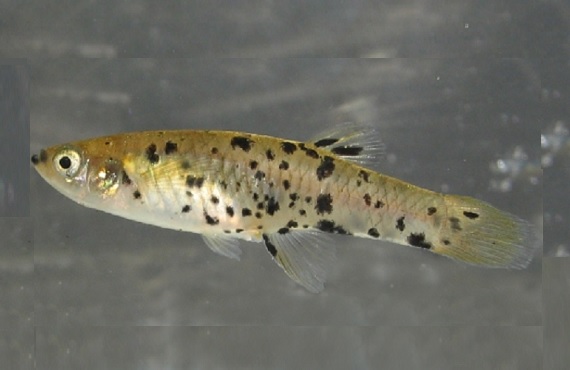Speckled mosquitofish
Introduction
 Speckled mosquitofish are brightly coloured, hardy and relatively easy to breed. As a result, they are a popular aquarium fish and have been transported around the world by the aquarium trade.
Speckled mosquitofish are brightly coloured, hardy and relatively easy to breed. As a result, they are a popular aquarium fish and have been transported around the world by the aquarium trade.
Speckled mosquitofish have been discovered in NSW waterways. This raises concerns about the potential impacts of yet another introduced freshwater fish in NSW, including the threat to native aquatic biodiversity.
It is extremely difficult to eliminate pest fish once they have become established in the wild. It is therefore vital to prevent noxious pests such as speckled mosquitofish from entering or spreading further in our waterways.
Natural distribution & biology
Speckled mosquitofish are native to eastern South America between Brazil and Uruguay.
They are a tiny livebearer (family Poeciliidae) and are similar in size and shape to the related Gambusia holbrooki (plague minnow or mosquitofish), although they are more yellowish in colour. The males are distinctively speckled with irregular black spots and blotches. Females can grow to 6 cm and males to 2.5 cm in length. They give birth to live young rather than laying eggs as most fish do, and produce broods of up to 80-100 offspring.
Speckled mosquitofish live in still ponds with dense aquatic vegetation. They are hardy and tolerate a wide range of environmental conditions. They mainly eat plant material and sediment. Contrary to popular belief, they do not consume a substantial number of mosquito larvae and have little value in mosquito control.
Where are they in NSW?
The only known wild population of speckled mosquitofish in NSW was discovered in March 2002 and subsequently eradicated by the department (see link to eradication report below). This population was discovered on Long Reef headland in northern Sydney in a series of ponds that form the water hazards of Long Reef Golf Course. Previously, speckled mosquitofish had only been recorded in Australia from several isolated locations including a few swamps and drains in the Perth metropolitan area and the Todd River system near Alice Springs. The discovery of the population in NSW is the first record of this species in eastern Australia.
How did they get here?
It is thought that speckled mosquitofish were introduced to the ponds in late 1999 and were likely to have been released from a home aquarium.
What are their impacts?
There have been no studies on the effects of speckled mosquitofish on Australia's aquatic ecosystems. However, the closely related introduced eastern gambusia, Gambusia holbrooki is considered to have had a major impact. Eastern gambusia - which were introduced from the late 1920's to the 1940s in an attempt to control mosquitoes - are now widespread throughout many of Australia's freshwater river systems and are regarded as a major pest. They have been implicated in the decline of a number of native fishes and frogs, including some threatened species. Eastern gambusia impact on these animals through predation, competition for food and habitat, direct aggression (e.g. fin-nipping) and the introduction of parasites.
Speckled mosquitofish are also likely to be highly competitive.
What is NSW DPIRD doing?
The department implemented a plan to manage speckled mosquitofish at Long Reef Golf Course in Northern Sydney in 2002. Several eradication attempts were made, one unsuccessful attempt in 2002, and a second attempt in 2006. Follow up monitoring of the ponds at Long Reef over two subsequent years have confirmed that the fish is no longer present. For more information, please read the following report report.
Under NSW legislation, it is illegal to buy or sell speckled mosquitofish, or to keep them in garden ponds or farm dams, without a permit. Heavy penalties apply for breaking these rules.
NSW DPIRD is also monitoring fish populations in coastal and inland rivers. If any new populations of speckled mosquitofish are discovered, where possible, action may be taken to control or remove them.
How you can help
Give unwanted aquarium fish to friends or a petshop, rather than letting them go in the wild (Note: it is illegal to release live fish into NSW waterways without a permit, and heavy penalties apply).
Be on the lookout for new species in your local waterways.
If you find any fish that you think might be speckled mosquitofish or another species not native to the area, freeze the fish whole and Report it!
References
- Allen GR, Midgley SH, Allen M. (2002). Freshwater fishes of Australia. Western Australian Museum, Perth.
- McDowall RM. (1999). Further feral poeciliid fish in New Zealand fresh waters, with a key to species. New Zealand Journal of Marine and Freshwater Research 33: 673–682.
- Rayner TS, Creese RG (2006) A review of rotenone use for the control of non-indigenous fish in Australian fresh waters, and an attempted eradication of the noxious fish, Phalloceros caudimaculatus. New Zealand Journal of Marine and Freshwater Research 40: 477–486
- Rowley JJL, Rayner TS, Pyke GH 2005. New records and invasive potential of the poeciliid fish Phalloceros caudimaculatus. New Zealand Journal of Marine and Freshwater Research 39: 1013–1022